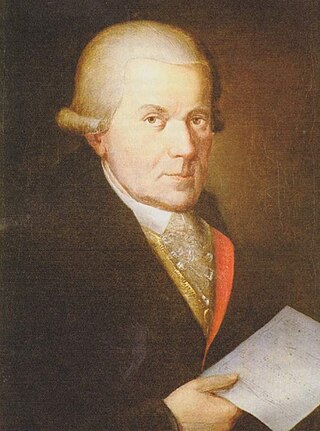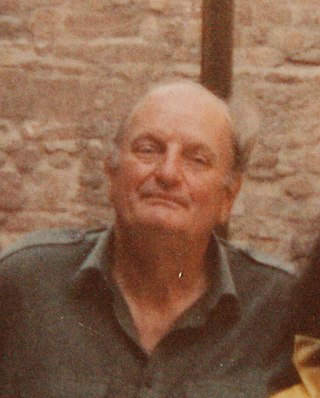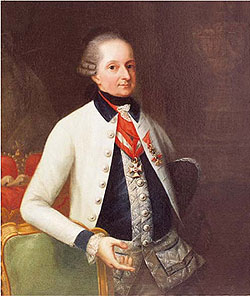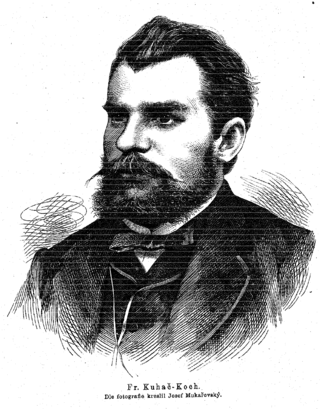Related Research Articles

Franz Joseph Haydn was an Austrian composer of the Classical period. He was instrumental in the development of chamber music such as the string quartet and piano trio. His contributions to musical form have led him to be called "Father of the Symphony" and "Father of the String Quartet".

Johann Michael Haydn was an Austrian composer of the Classical period, the younger brother of Joseph Haydn.
Johann Evangelist Haydn was a tenor singer of the classical era; the younger brother of the composers Joseph Haydn and Michael Haydn. He was often called "Hansl", a diminutive form of "Johann".

Howard Chandler Robbins Landon was an American musicologist, journalist, historian and broadcaster, best known for his work in rediscovering the huge body of neglected music by Haydn and in correcting misunderstandings about Mozart.

"Gott erhalte Franz den Kaiser" was a personal anthem to Francis II, Emperor of the Holy Roman Empire and later of the Austrian Empire, with lyrics by Lorenz Leopold Haschka (1749–1827) and music by Joseph Haydn. It is sometimes called the "Kaiserhymne". Haydn's tune has since been widely employed in other contexts: in works of classical music, in Christian hymns, in alma maters, and as the tune of the "Deutschlandlied", the national anthem of Germany.
Symphony No. 103 in E♭ major is the eleventh of the twelve London symphonies written by Joseph Haydn. This symphony is nicknamed The Drumroll after the long roll on the timpani with which it begins. It is from 1795, and his second-to-last symphony.
The composer Joseph Haydn is sometimes given the nickname "Papa" Haydn. The practice began in Haydn's lifetime and has continued to the present day.

Nikolaus I, Prince Esterházy was a Hungarian prince, a member of the famous Esterházy family. His building of palaces, extravagant clothing, and taste for opera and other grand musical productions led to his being given the title "the Magnificent". He is remembered as the principal employer of the composer Joseph Haydn.

Franjo Ksaver Kuhač was an Austro-Hungarian piano teacher, choral conductor, composer, and comparative musicologist who studied Croatian folk music. Kuhač did a great deal of field work in this area, collecting and publishing 1,600 folk songs. Like Cecil Sharp, who did similar work in Britain and Appalachia, Kuhač published the folk songs with a piano accompaniment.

The composers Wolfgang Amadeus Mozart (1756–1791) and Joseph Haydn (1732–1809) were friends. Their relationship is not very well documented, but the evidence that they enjoyed each other's company is strong. Six string quartets by Mozart are dedicated to Haydn.
Maria Anna Sabina (von) Genzinger, called Marianne, was a Viennese amateur musician, the mother of six children, and a friend of the composer Joseph Haydn. Her correspondence with Haydn preserves a personal view of the composer not available from any other biographical source. Her daughter Josepa was a singer who gave the first performance of Haydn's Ariadne auf Naxos.

AnnaSelina Storace, known professionally as Nancy Storace, was an English operatic soprano. The role of Susanna in Mozart's Le nozze di Figaro was written for and first performed by her.
Luigia Polzelli was an Italian mezzo-soprano, who sang at the Esterházy court in Hungary during the late 18th century. She was for a number of years the lover of the composer Joseph Haydn.
Gregor Joseph Werner was an Austrian composer of the Baroque period, best known as the predecessor of Joseph Haydn as the Kapellmeister of the Hungarian Esterházy family. Few of Werner's works survive to the present day, and he is mostly remembered for his troubled relationship with Haydn.
Mathias Haydn was the father of two famous composers, Joseph and Michael Haydn. He worked as a wheelwright in the Austrian village of Rohrau, where he also served as Marktrichter, an office akin to village mayor.

The celebrated composer Joseph Haydn died in Vienna, aged 77, on May 31, 1809, after a long illness. As Austria was at war and Vienna occupied by Napoleon's troops, a rather simple funeral was held in Gumpendorf, the parish in Vienna to which Haydn's house on the Windmühle belonged, followed by burial in the Hundsturm cemetery. Following the burial, two men conspired to bribe the gravedigger and thereby sever and steal the dead composer's head. These were Joseph Carl Rosenbaum, a former secretary of the Esterházy family, and Johann Nepomuk Peter, governor of the provincial prison of Lower Austria. Rosenbaum was well known to Haydn, who during his lifetime had intervened with the Esterházys in an attempt to make possible Rosenbaum's marriage to the soprano Therese Gassmann.
Rebecca (Scott) Schroeter (1751–1826) was an amateur musician who lived in London during the 18th and early 19th centuries. She was the wife of the German composer Johann Samuel Schroeter, and later, during her years of widowhood, a love interest of Joseph Haydn.
This article discusses the influence of folk music on the work of the composer Joseph Haydn (1732–1809).

Philemon und Baucis, oder Jupiters Reise auf die Erde, Hob. XXIXb:2, is an opera in one act by Austrian composer Joseph Haydn to a German libretto, possibly by Prince Esterházy's librarian, Phillip Georg Bader. The text is based upon a play by G. K. Pfeffel, itself a retelling of the Baucis and Philemon myth from Ovid's Metamorphoses. The work is in the form of a Singspiel.
References
- ↑ For further background on the northern Croat diaspora, see Burgenland Croats.
- ↑ Kuhač (1880, cited below)
- ↑ The work was published as Schmidt (1934).
- ↑ Geiringer 1982, 4
- ↑ Quotation taken from the 1982 reprinting in book format of Larsen's article; see References below.
- ↑ The current edition is online; copyright Oxford University Press, 2007
- ↑ Quoted in Robbins Landon and Jones 1988, 306